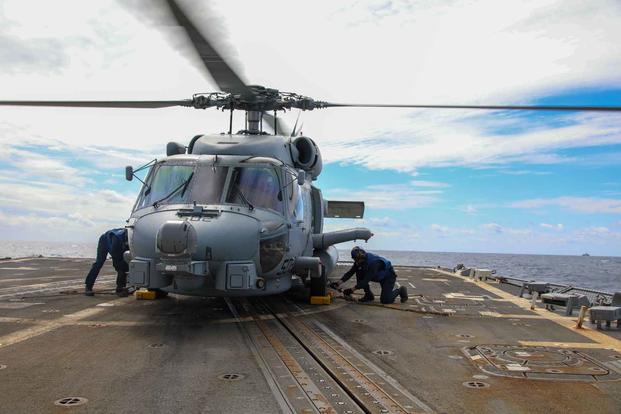A Navy dive and salvage team has recovered the bodies of three soldiers and the Army MH-60 Black Hawk helicopter they were in that crashed into the Mediterranean Sea in November, the service announced Thursday.
"Everyone onboard was humbled by the opportunity to play a small role in helping to bring closure to grieving families," Cmdr. John Kennedy, the Navy officer leading the task group in charge of the effort, said in the Thursday press release.
According to the Army's Special Operations Command, which also released a statement Thursday, the aircraft was recovered on Dec. 15 and the remains of three soldiers that were aboard were flown to Dover Air Force Base, Delaware, for identification. Two others died when the helicopter crashed, but their remains were found in the immediate aftermath of the accident.
Read Next: The US Wanted Out of the Middle East. The Middle East Had Other Ideas.
The five-soldier crew was part of the Army's Special Operations Command and assigned to 1st Battalion, 160th Special Operations Aviation Regiment (Airborne). The Black Hawk was conducting aerial refueling training when "the aircraft experienced an in-flight emergency, resulting in the crash," the Army said.
The crash took place amid a U.S. force buildup in response to Hamas' brutal terror attack on Israeli civilians and the subsequent Israeli military response in Gaza.
At the time, a senior defense official wouldn't say whether the Army special operations unit was in the area to support Israel but did say that it was "there in response to the dynamic security environment in the region." A statement from U.S. European Command also stressed that "the aircraft sortie was purely related to training and there are no indications of hostile activity."
The Navy used experts from its Supervisor of Salvage and Diving command, as well as sailors from Explosive Ordnance Disposal Mobile Unit 8 and soldiers from the Army's Special Operations Aviation Command, in the search, the Navy's statement said. The team contracted a multipurpose vessel, the NG Worker, and proceeded to the crash site on Dec. 8.
"Once on station, highly skilled operators located and recovered the aircraft using state-of-the-art underwater survey and recovery equipment mounted on the Deep Drone remote operated vehicle," the Navy said in its statement.
Although neither statement noted the depth of the sunken helicopter, the Deep Drone used in the effort has a maximum operating depth of 8,000 feet.
The Navy's Supervisor of Salvage and Diving is routinely called in to recover aircraft and other objects that sink to the bottom of the ocean. In March 2022, the command recovered a F-35C Lightning II fighter that had crashed into the deck of the aircraft carrier USS Carl Vinson several months prior before sliding off and sinking more than 12,000 feet into the South China Sea.
The command also provided equipment and expertise to the massive rescue-and-recovery effort of the Titan -- a private submersible that imploded while conducting a dive to the wreck of the Titanic.
The victims of the crash are Chief Warrant Officer 3 Stephen R. Dwyer, 38, of Clarksville, Tennessee; Chief Warrant Officer 2 Shane M. Barnes, 34, of Sacramento, California; Staff Sgt. Tanner W. Grone, 26, of Gorham, New Hampshire; Sgt. Andrew P. Southard, 27, of Apache Junction, Arizona; and Sgt. Cade M. Wolfe, 24, of Mankato, Minnesota.
Neither the Navy nor Army offered the identities of the three soldiers who were recovered as part of the salvage effort. The Navy cited pending next-of-kin notification as the reason.
The remains of two soldiers were recovered during initial search-and-recovery efforts in November.
Army Special Operations Command said that the cause of the crash is still being investigated.
-- Konstantin Toropin can be reached at konstantin.toropin@military.com. Follow him on X at @ktoropin.
Related: Army Identifies 5 Special Operations Soldiers Killed in Black Hawk Crash in Mediterranean Sea














